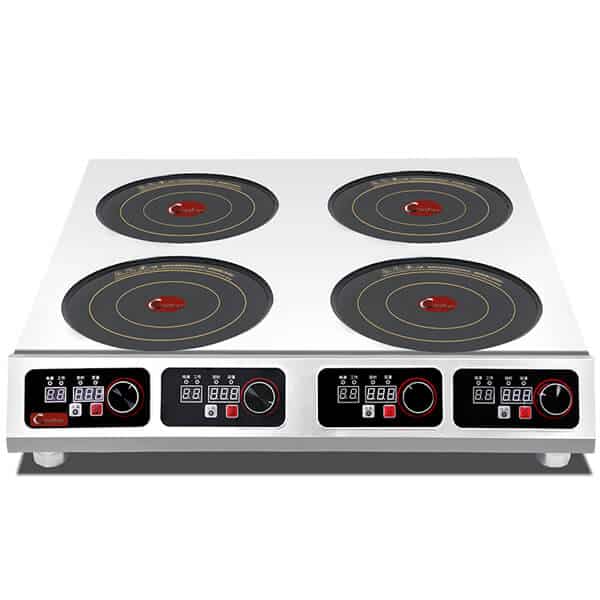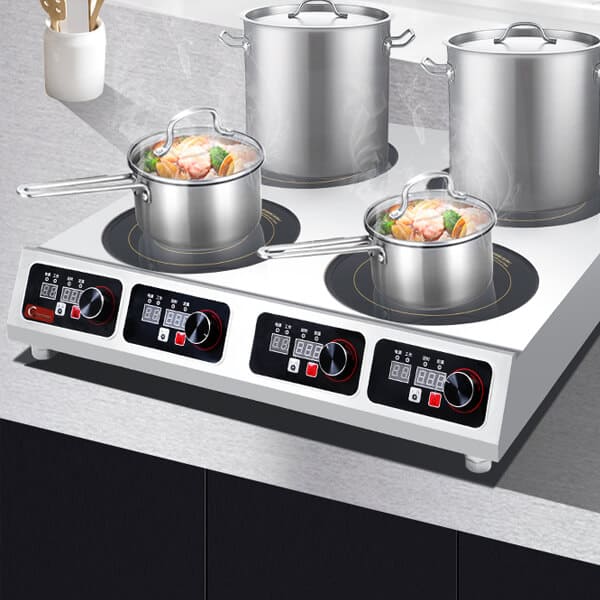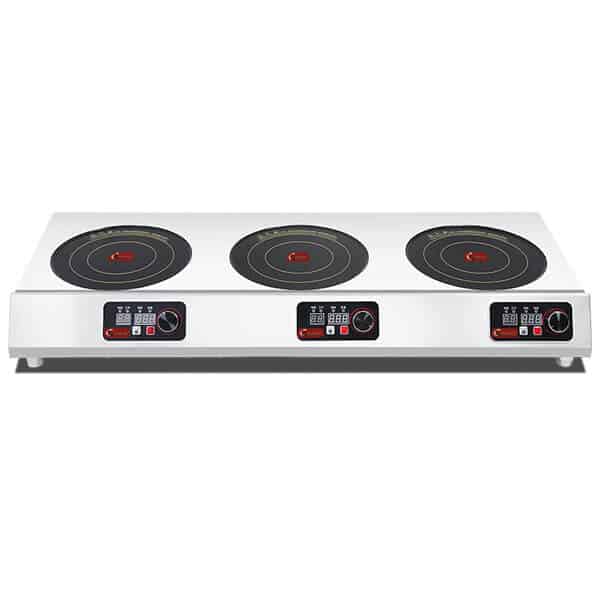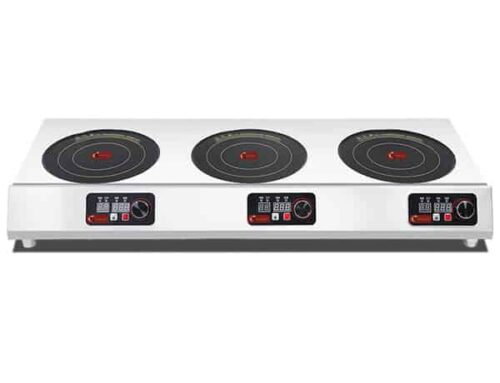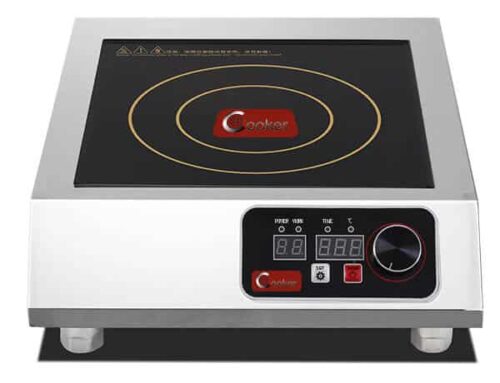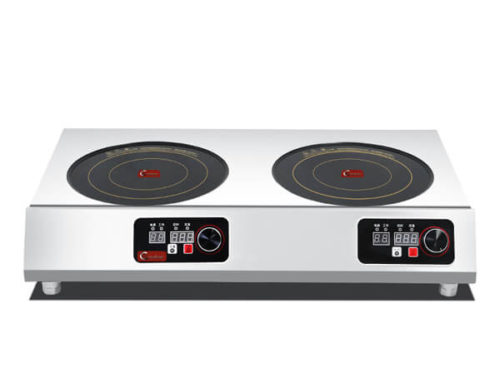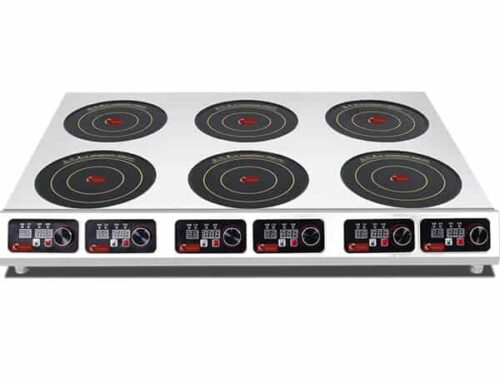Commercial induction stoves are typically 85-90% energy efficient, whereas gas stoves are around 40-55% efficient.
When evaluating kitchen equipment, energy efficiency is a critical factor that directly impacts operational costs. commercial induction stove units demonstrate remarkable performance in this area, typically operating at 85-90% energy efficiency. This means the vast majority of electrical energy consumed is converted directly into heat for cooking. In stark contrast, traditional gas stoves operate at only 40-55% efficiency, according to data from the U.S. Department of Energy. The significant efficiency gap translates to substantial energy savings for kitchen operators, making the commercial induction stove price a worthwhile investment when considering long-term operational costs.
Induction stoves heat cookware directly through electromagnetic fields, minimizing energy loss compared to gas stoves, which lose energy as heat dissipates into the air.
The fundamental difference in heating technology explains the dramatic efficiency advantage of commercial induction hob built in models. Induction cooking uses electromagnetic energy to create heat directly within the cookware itself, bypassing the need to heat a cooking surface first. This direct energy transfer means almost no heat is wasted to the surrounding environment. Conversely, gas stoves must first heat a burner, which then transfers heat to the cookware while losing substantial energy to the surrounding air through convection and radiation. This inefficient process means nearly half of the energy generated by a gas flame never actually contributes to cooking food, making built in commercial induction stove units far more efficient for commercial kitchen operations.
The rapid heating capability of induction stoves reduces cooking time, contributing to overall energy savings.
Speed is another significant efficiency advantage of commercial induction stove technology. Because induction delivers heat directly to the cookware, it can bring water to a boil up to 50% faster than traditional gas burners. This rapid heating capability means the cooking process begins sooner and finishes faster, reducing the total energy consumption per cooking task. In a high-volume commercial kitchen where time equals money and energy, these time savings accumulate significantly throughout the day. A powerful commercial induction stove 8KW model can complete more cooking cycles in the same timeframe, maximizing throughput while minimizing energy usage per meal prepared.
| Performance Metric | Commercial Induction Stove | Commercial Gas Stove | Efficiency Advantage |
|---|---|---|---|
| Thermal Efficiency | 85-90% | 40-55% | +35-50% |
| Water Boiling Time (2L) | ~4 minutes | ~8 minutes | 50% faster |
| Ambient Heat Loss | Minimal (10-15%) | Significant (45-60%) | 70-80% less waste |
| Response Time (Temp Change) | Instantaneous | 15-30 seconds | Near-instant control |
Induction stoves provide precise temperature control, which can lead to more efficient energy use during cooking processes.
Precision control is a hallmark of commercial induction hob built in technology, contributing significantly to energy efficiency. Unlike gas stoves that require gradual adjustment of flame size, induction stoves offer immediate response to temperature changes. When you reduce the power setting on a built in commercial induction stove, the heat output adjusts instantly, eliminating the energy waste that occurs while waiting for a gas burner to cool down. This precise control allows chefs to maintain exact temperatures for delicate cooking tasks like simmering sauces or melting chocolate without energy-wasting temperature fluctuations. The ability to dial in exact power levels means energy is used only as needed, without the overshooting and undershooting common with gas combustion systems.
The cool-to-touch surface of induction stoves reduces ambient heat in the kitchen, potentially lowering air conditioning costs.
One of the most noticeable differences with commercial induction stove units is how little waste heat they generate. Since the cooking surface itself doesn’t get hot (only the cookware does), the kitchen environment remains significantly cooler. This has a direct impact on HVAC costs, as air conditioning systems don’t need to work as hard to remove excess heat. In contrast, gas stoves radiate substantial heat into the kitchen space, raising ambient temperatures and forcing HVAC systems to consume more energy to maintain comfortable working conditions. The commercial induction stove price should be evaluated against these secondary energy savings, which can be particularly valuable in warm climates or during summer months when cooling costs are highest.
Induction technology eliminates the need for preheating, further enhancing energy efficiency compared to gas stoves.
The instant-on capability of commercial induction stove technology eliminates one of the most significant sources of energy waste in commercial kitchens: preheating time. Gas stoves require several minutes to reach optimal cooking temperature, during which energy is consumed without any productive cooking output. A commercial induction stove 8KW model, however, delivers full power immediately, allowing cooking to begin the moment the unit is activated. This eliminates the energy waste associated with preheating empty cookware or waiting for cooking surfaces to reach temperature. The cumulative effect of eliminating preheating across multiple cooking sessions throughout the day adds up to substantial energy savings that directly impact the bottom line.
Induction stoves often have automatic shut-off features, preventing energy waste when cookware is removed.
Smart energy management features further enhance the efficiency of modern commercial induction hob built in units. Most models include automatic safety shut-off features that detect when cookware is removed from the cooking surface and automatically power down the heating element. This prevents energy from being wasted heating an empty cooking surface—a common occurrence in busy commercial kitchens when pans are moved between stations or ingredients are transferred. Gas stoves lack this intelligent feature, continuing to consume fuel until manually turned off. This automated energy conservation represents another layer of efficiency that makes built in commercial induction stove equipment particularly valuable in high-paced kitchen environments where staff may not always remember to turn off burners immediately.
The efficiency of induction stoves can lead to reduced operational costs over time, despite potentially higher initial purchase prices.
While the upfront commercial induction stove price may be higher than comparable gas equipment, the long-term operational savings create a compelling financial case. The combination of higher energy efficiency, reduced ventilation requirements, and lower HVAC costs typically results in a rapid return on investment. Most commercial kitchen operators find that the energy savings alone can offset the price difference within 1-2 years of operation, with continued savings accruing throughout the equipment’s lifespan. When evaluating a commercial induction stove, it’s essential to consider the total cost of ownership rather than just the initial purchase price, as the operational savings frequently make induction the more economical choice over time.
Induction cooking reduces the need for ventilation due to the absence of combustion gases, resulting in additional energy savings.
Ventilation represents a significant hidden energy cost in commercial kitchens that is dramatically reduced with induction technology. Gas stoves require powerful ventilation systems to remove combustion byproducts, heat, and moisture from the kitchen environment. These ventilation systems consume substantial electricity to operate. Since commercial induction stove units don’t produce combustion gases and generate minimal ambient heat, they require significantly less ventilation. This translates to lower energy consumption by exhaust fans and reduced makeup air heating/cooling costs. The energy savings from reduced ventilation requirements can be substantial, particularly in larger facilities where ventilation systems represent a major portion of total energy usage.
The consistent and even heat distribution of induction stoves can enhance cooking results, reducing the need for energy-intensive corrections.
Superior heat distribution is another efficiency advantage of commercial induction hob built in technology. Induction creates exceptionally even heating across the entire bottom surface of compatible cookware, eliminating hot spots that can cause burning or uneven cooking. This consistent heating means food cooks more uniformly, reducing the need for energy-wasting corrective actions like stirring excessively, adjusting temperatures frequently, or even discarding and restarting poorly cooked items. The precision of a built in commercial induction stove leads to better cooking outcomes on the first attempt, minimizing food waste and the energy required to prepare replacement dishes—an often overlooked aspect of kitchen efficiency.
Induction stoves are particularly efficient in high-volume cooking environments where energy savings can be more pronounced.
The efficiency advantages of commercial induction stove technology become increasingly valuable in high-volume cooking environments. Restaurants, catering facilities, institutional kitchens, and other operations with continuous cooking demands benefit most from the cumulative energy savings. The more frequently cooking equipment is used, the greater the absolute energy savings compared to gas alternatives. A high-power commercial induction stove 8KW model operating through multiple service periods daily will deliver dramatically lower energy costs than an equivalent gas burner performing the same workload. This makes induction technology particularly well-suited to operations where cooking equipment sees heavy use throughout extended service hours.
The lower energy consumption of induction stoves contributes to a smaller carbon footprint compared to gas stoves.
Beyond direct cost savings, the energy efficiency of commercial induction stove technology offers significant environmental benefits. The substantially lower energy consumption translates to a reduced carbon footprint, particularly when the electricity comes from renewable or low-carbon sources. Even when accounting for emissions from electricity generation, induction cooking typically results in lower greenhouse gas emissions than natural gas combustion. As noted in a study published in Applied Energy, induction cooking can reduce carbon emissions by 25-40% compared to gas cooking when considering the full energy lifecycle. This environmental advantage makes the commercial induction stove price an investment in sustainability as well as operational efficiency.
Induction stoves maintain efficiency across a range of cooking tasks, from simmering to boiling, offering versatility and energy conservation.
Unlike some cooking technologies that excel at high-heat tasks but waste energy at lower settings, commercial induction hob built in units maintain high efficiency across their entire power range. Whether operating at maximum power to rapidly boil large volumes of water or at minimal settings for gentle simmering, induction technology efficiently transfers energy to the cookware with minimal waste. This consistent efficiency across diverse cooking applications makes built in commercial induction stove equipment exceptionally versatile for commercial kitchens that need to perform a wide variety of cooking techniques. The ability to maintain high efficiency whether searing, frying, boiling, or simmering means energy savings accumulate throughout all kitchen operations, not just high-heat applications.
| Cost Factor | Commercial Induction Stove | Commercial Gas Stove | Annual Savings |
|---|---|---|---|
| Direct Energy Cost | $720 | $1,620 | $900 |
| Ventilation Energy | $240 | $600 | $360 |
| HVAC Impact | $180 | $540 | $360 |
| Total Annual Energy Cost | $1,140 | $2,760 | $1,620 |

